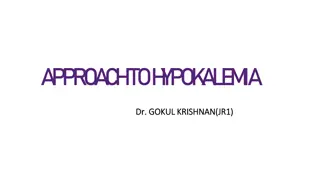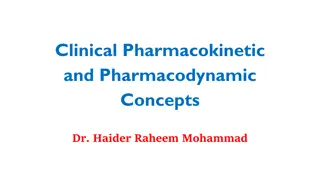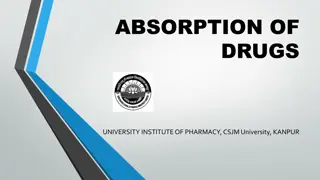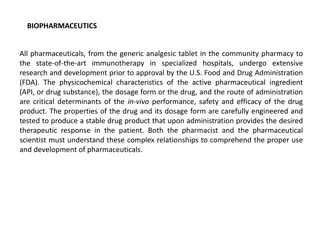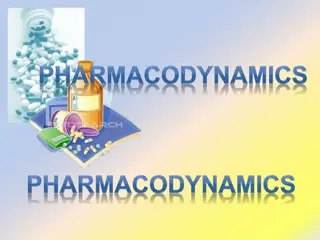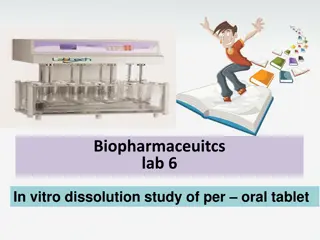Understanding Drug Absorption, Excretion, and Bioavailability in Humans
Delve into the complex processes of drug absorption, excretion, and bioavailability in the human body. Learn about the various factors affecting drug absorption from the gastrointestinal tract, including biological, physiochemical, and pharmaceutical factors. Explore the mechanisms of drug transport across cell membranes and the importance of excretion in eliminating drug molecules from the bloodstream. Gain insights into how drugs move through the body and the crucial role these processes play in pharmacology and toxicology studies.
Download Presentation

Please find below an Image/Link to download the presentation.
The content on the website is provided AS IS for your information and personal use only. It may not be sold, licensed, or shared on other websites without obtaining consent from the author. Download presentation by click this link. If you encounter any issues during the download, it is possible that the publisher has removed the file from their server.
E N D
Presentation Transcript
Study of Absorption, Excretion and Bioavailability of Drugs in Human (Lab 8) Department of Pharmacology and Toxicology University of Al-Mustansiriyah 2018-2019
Absorption: Defined as the passage of a drug from its site of administration into the plasma. Therefore, it is important for all routes of administration, except intravenous injection. Cell membranes form the barriers between aqueous compartments in the body. An epithelial barrier, such as the gastrointestinal mucosa or renal tubule, consists of a layer of cells tightly connected to each other so that molecules must traverse at least two cell membranes (inner and outer) to pass from one side to the other.
Types of transport across cell membrane : Diffusion through lipid layers Transfer through aqueous pores Transport by carrier proteins: which include two main subtypes:. a. Passive transport b. Active transport: Need energy to transport against concentration gradient. Pinocytosis
Factors affecting the absorption of drug from GIT: Biological factors Physiochemical factors Pharmaceutical factors
Biological factors: surface area of GI absorption sites pH of gastrointestinal fluids Gastrointestinal motility Influence of food and diet in GIT Hepatic metabolism (first pass effect) Gastrointestinal disorders and presence of disease states
Physiochemical factors: Drug dissociation constant Lipid solubility Dissolution rate of drugs Drug stability and degradation condition in GIT Drug interaction properties with other constituents
Pharmaceutical factors: Types of dosage forms Influence of excipients Polymorphisms
Excretion: Excretion is the elimination of drug molecules from the bloodstream outside the body. Drugs are excreted or eliminated parent compounds or metabolites. fromthe body as
Renal excretion: The kidney is the most important organ for the excretion of drugs and/or their metabolites. Some compounds are also excreted via bile, sweat, saliva, exhaled air, tears, hairs or milk, the latter a possible source of unwanted exposure in nursing infants. Drugs need to be reasonably hydrophilic to be excreted by the kidney, so that they will remain in the fluid that becomes the urine.
Patients with impaired kidney function usually have a reduced ability to eliminate hydrophilic drugs. To avoid excessively high drug concentrations in these patients, you will need to reduce their dosages or give dosages less frequently.
Factors affecting the excretionof body: Biological factors Physiochemical factors Pharmaceutical factors drug from the
Biological factors: Surface area of excretion sites pH Hepatic metabolism Renal and hepatic disorders and presence of disease states
Physiochemical factors: Lipid solubility Dissolution rate of drugs Drug interaction Molecular size Protein and tissue binding Doses administrated properties with other constituents
Pharmaceutical factors: Types of dosage forms Influence of excipients
Saliva: In recent years, saliva has been utilized for therapeutic drug monitoring (TDM). The advantage is that collection is noninvasive and painless and so it has been used as a specimen of choice in pediatric TDM.
Due to the low protein content of saliva, it is considered to represent the unbound or free fraction of drug in plasma. Since this is the fraction considered available for transfer across membranes and therefore responsible for pharmacological activity, its usefulness is easy to understand.
Potassium iodide (KI): KI It's a salt of iodine added to Iodized table salt to keep most people healthy under normal conditions. KI is a safe and medically effective drug; Short-term use of KI at the proper dosage is safe for most people. KI is available without a prescription. The thyroid gland needs iodine to carry out its hormone production and iodine deficiency can cause hypothyroidism and most of the stable iodine in our bodies comes from the diet.
KI drops used topically in treatment of acne, sebaceous Cyst, nasal polyps, local anti-septic, and nail fungus. KI used also as expectorant to liquefy the thick sputum and in tonsillitis as gargle with water. KI included in Lugol s solution which is given to prepare patients for thyroidectomy because it reduces the vascularity of the gland and makes it harder and less friable by the action of Iodine that inhibits the release of thyroid hormones.
Objectives of the experiment: The aims of this experiment is to illustrate the considerable variation that exists in the rate of absorption and excretion of potassium iodide in two different dosage forms (capsule ,solution) when administered orally. At the end of the practical class the student should be able to: Quantitatively estimate the levels of iodide in the saliva. Understand the importance of timing sample collection in relation to drug intake when estimating drug levels. Understand the importance of bioavailability and pharmacokinetics in clinical practice.
Materials: Drugs and solutions: Potassium iodide 300mg capsules Potassium iodide 300mg/5ml solution Sulphuric acid 10% solution Hydrogen peroxide 5% Starch solution 1% in distilled water. Apparatus: Droppers, containers and test tubes.
Procedure: Assigned students into 2 groups: A random sample of students was allocated to receive potassium iodide 300 mg in capsules and another receives potassium iodide 300 mg in solution. Two samples of saliva are collected every 10 minutes for 1 hour. These samples are tested as follow: Testing the samples of saliva : 4 drops (saliva) + 5 drops (H2O2) + 4 drops (H2SO4) +1 ml starch solution Shaking for 3 seconds. Blue color indicate a positive test (presence of iodide) ,the intensity of which indicates the concentration of KI. The approximate values are obtained (+ve,++ve,+++ve .etc). Tabulate the results and plotted in a graph paper (X axis time, Y axis concentration) to show the rate of excretion consequent to absorption as below: by color intensity
Results: Time KI (capsule) KI (solution) Presence of iodide in Saliva Presence of iodide in Saliva 10 min 20 min 30 min 40 min 50 min 60 min
Plot the graph (X axis time, Y axis concentration (intensity of the color) to show the rate of excretion consequent to absorption of capsules vs. solution dosage forms
Discussion: Compare the absorption of KI capsules vs. dosage forms. Advantages of TDM by using Saliva for estimating drug levels. rate of excretion consequent to KI solution




